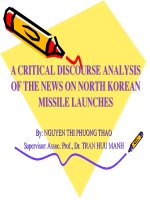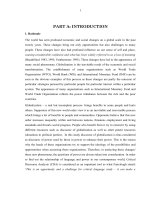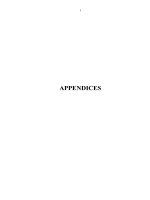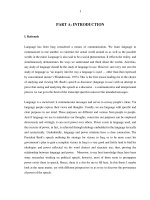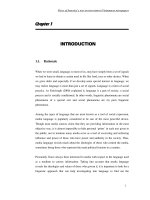A critical discourse analysis of the news on north korean missile launches part 4
Bạn đang xem bản rút gọn của tài liệu. Xem và tải ngay bản đầy đủ của tài liệu tại đây (157.54 KB, 20 trang )
INTRODUCTION
1. Rationale
Among the various inventions that mankind has ever made, language is one of the greatest.
Different societies or different groups of people are featured with different languages,
different cultures, different political and economic power. The strong correlation between
these “features” can obviously be seen throughout human history. If the marvelous
development of ancient Chinese culture was attributed to the rapid expansion of Chinese
language in the old days, in contemporary society the domination of English implies the
superpower of the United States and Western nations. When a nation’s power grows, more
and more people try to learn its language, and when less and less people speak a certain
language, that means a race is facing extinction. The connection between language and
power also exists inside any community where different groups of people possess different
political and economic power. The difference in power will inevitably result in different
social attitudes and different value standards. Thus, from the Critical Discourse Analysis
(henceforth CDA) perspective, these different groups of people do not actually use the same
“language”. It means that language can be manipulated to gain power, selective texts and
talks can be employed to achieve a particular purpose, just as Fairclough put it “exercise of
power is increasingly achieved through ideology, particularly through the workings of
language” (Fairclough, 2000). In that sense, discourse has been seen as not only social
practice but also reflection of ideology, thus CDA can help revealing the hidden effects of
language embodied in various types of discourse.
With the aim of dealing with social problems by means of language, CDA defined as
discourse analysis ‘with an attitude’ is a useful tool in language use analysis contributing
positively to the process of struggling for power equality. Having been used successfully in
discerning the relationship between language, power and ideology in a wide range of
contexts, CDA is attracting growing interest of a number of worldwide language researchers.
It is so much hoped that this study may bring an illustration of the CDA concepts, helping
1
clarify them by analyzing some news reports on North Korea missile launches - one of the
hottest issues these days. The news reports are chosen to be analyzed on the assumption that
politics is the field where a struggle of power and ideology always exists in one way or
another. In analyzing the news reports, we are trying to reveal what is coded in the language
use, thus raising the awareness of how language pictures reality and influences our
perception of the world.
2. Scope of the research
In this research, we would like to focus only on the written text of the news on North Korea
missile launches from July 4
th
2006 to July 28
th
2006. We are well aware that the wider the
range of data we achieve from, the more reliable the research results will be. However,
within the constraint of time and the limited length of a minor thesis, the data we opted for
include 32 headlines and 18 news articles in English and Vietnamese from the two sources of
news: the Voice of America and Nhan Dan.
As this is a pure linguistic study, we are not, in any way, expressing our own political point
of view. The study, therefore, does not support any political parties or aim at changing
anyone’s political stance. It is for academic purpose only.
3. Aims of the research and research questions
In analyzing the news on North Korea missile launches, the study aims at:
- Providing a textual analysis of the news on North Korea missile launches in the light of
Critical Discourse Analysis.
- Giving an illustration of the CDA concepts as well as analysis procedures.
- Conveying a message that CDA provides a useful, systematic way for us- language users
and language learners- to begin raising awareness of the ideology of discourse texts in
general. This is important because language not only reflects and records but also shapes,
distorts and even creates realities, both cultural and natural.
2
To achieve these aims, we have posed the following research questions:
- What are the representations of North Korea and the United States (US)- Japan coalition
by VOA and Nhan Dan during the time in question?
- What are the underlying ideologies embedded in the ways VOA and Nhan Dan represent
North Korea and the US- Japan coalition?
- Why are such ideologies encoded in the discourse of the two news sources?
These questions are based on several assumptions. First, the news reports are influenced by
certain values of the producers, including both the writers and the media institutions. Second,
VOA and Nhan Dan can reflect different viewpoints on the foreign policies of the US and
Japan towards North Korea missile tests during the period of time in question. Third, and as
a result, representations of North Korea and the US- Japan coalition by these two news
sources can be ideologically different.
4. Methodology
The first step taken during the whole course of the research is to conduct a literature review
in order to gain and present an understanding of the issues relevant to the research topic. This
will provide a theoretical framework for the findings of the study. Then news reports on
North Korea missile launches from July 4
th
2006 to July 28
th
2006 are collected from the
Voice of America and Nhan Dan. The data for analysis are sampled through random
sampling. The selected data are thoroughly examined. The aim of this step is to closely look
at prominently linguistic features in the data so as to decide on appropriate analytical tools.
The study aims at investigating media discourse as a social practice and probing into
ideological differences in representing North Korea and the US- Japan coalition by VOA and
Nhan Dan. It is conducted deductively with a view to looking into prominently linguistic
features and discursive strategies for evidences that prove certain assumptions regarding the
two sources’ ideological purposes. Thus, two sets of data are investigated: headlines and
full-text news reports.
- Analyzing selected headlines according to transitivity system.
3
- Analyzing sampled full-text news reports according to different discursive features and
strategies.
Through the analysis of the two sets of data, the study has attempted to find out the
similarities and differences in the ways VOA and Nhan Dan used certain discursive features
and strategies to represent North Korea and the US- Japan coalition. Based on the findings,
we have made further discussion about the different ideologies embedded in the news
discourse.
5. Background information
It is necessary to give some brief background information of the data in order to provide the
contextual basis for a better understanding and a more thorough analysis of the news
discourse. The test came on the heels of the Six-party talks between North Korea, China,
Japan, Russia, South Korea and the United States. North Korea withdrew from the Nuclear
Non-Proliferation Treaty in 2003. Recently during "Six-party talks" North Korea agreed in
principle to end its nuclear weapons program as part of a comprehensive package of
measures to normalize relationships. Diplomatic efforts at resolving the North Korean
situation are complicated by the different goals and interests of the nations of the region.
Two rounds of North Korean missile tests were conducted on July 5 2006. The Democratic
People's Republic of Korea (DPRK or North Korea) reportedly fired at least seven separate
missiles. These included two short-range Nodong-2 missiles, one Scud missile and up to two
long-range Taepodong-2 missiles; the latter having been estimated by United States
intelligence agencies as having a potential range reaching as far as Alaska in its current
stage. Some, including Australian Foreign Minister Alexander Downer, believed that North
Korea would carry out additional missile tests in the days that followed.
North Korea made its first public acknowledgement of the tests on July 6, through its foreign
ministry, describing them as "successful" and part of "regular military drills to strengthen
self-defense," insisting that it had the legal right to do so. The country warned of "stronger
physical actions" if it were put under pressure by the international community. Many experts
4
believe that the timing, which was in the very early hours of July 5 in Korea, but midday of
July 4 in the US (US Independence Day), was deliberate to get attention from the US, and
possibly, an attempt for one on one talks rather than the six-party talks regarding North
Korea's nuclear capabilities.
6. Design of the research
The study is divided into three main parts:
- Part 1- Introduction: This part includes the rationale, the scope of the research, the aims
of the research, the methodology and the design of the research.
- Part 2- Development: This is the main part of the thesis and has three chapters.
Chapter 1- Theoretical Background: This chapter presents all related theoretical
background that precedes and necessitates the formation of our research.
Chapter 2- Methodology: This chapter describes the sources of data as well as the
research procedures that have been utilized in the study.
Chapter 3- Data Analysis and Discussion: This chapter analyzes the data and discusses
the findings of the analysis.
- Part 3- Conclusion: This part summarizes the findings, draws important conclusions and
offers suggestions for further research.
5
Chapter 1
THEORETICAL BACKGROUND
1.1. The history of Critical Linguistics and Critical Discourse Analysis
Before the 1970s, linguistic research was focused on formal aspects of language which
constituted the linguistic competence of speakers and which could theoretically be isolated
from specific instances of language use (Chomsky, 1957). Where the relation between
language and context was considered, as in pragmatics, with a focus on speakers’ pragmatic
or socio-linguistic competence, sentences and components of sentences were still regarded as
basic units. Much socio-linguistic research at the time was aimed at describing and
explaining language variation, language change and the structures of communicative
interaction, with limited attention to issues of social hierarchy and power. The 1970s saw the
emergence of a form of discourse and text analysis that recognized the role of language in
structuring power relations in society. This new approach to linguistic research drew the
attention of many researchers, among them the most prominent are Kress and Hodge (1979),
Fowler et al. (1979), van Dijk (1985), Fairclough (1989), and Wodak (ed.) (1989). Their
work serves to explain and illustrate the main assumptions, principles and procedures of
what had then become known as Critical Linguistics or Critical Discourse Analysis (CDA).
Kress (1979) gives an account of the theoretical foundations and sources of critical
linguistics. He shows how CDA by that time was ‘emerging as a distinct theory of language,
a radically different kind of linguistics’ (Kress, 1990, quoted in Wodak, 2001:5). He also
lists the criteria that characterize work in the critical analysis paradigm, illustrating how
these distinguish such work from other politically engaged discourse analysis. Perhaps, one
of the most important results of Kress’s work is the assumptions of CDA, which were used
and elaborated by researchers of both the early stages as well as the later development of the
theory. These assumptions are:
Language is a social phenomenon.
6
Not only individuals but also institutions and social groupings have specific meanings
and values that are expressed in language in systematic ways.
Texts are the relevant units of language in communication.
Readers/ hearers are not passive recipients in their relationship to texts.
There are similarities between the language of science and the language of institutions,
and so on.
(Kress, 1990, quoted in Wodak, 2001:6)
The works of Fowler, et al. (1979) ascertain the early foundations of CDA. Fowler’s later
works (1991, 1996) show how tools provided by standard linguistic theories (Chomskyan
grammar and Halliday’s theory of systemic functional grammar) can be used to discern
linguistic structures of power in texts. He also points out how systematic grammatical
devices function in establishing, manipulating and naturalizing social hierarchies.
Fairclough (1989) sets out the social theories underpinning CDA and as in other early critical
linguistic work, a variety of textual examples are analyzed to illustrate the field, its aims and
methods of analysis. Later, Fairclough (1992, 1995) and Chouliariki and Fairclough (1999)
explain and elaborate some advances in CDA, showing not only how the analytical
framework for investigating language in relation to power and ideology developed, but also
how CDA is useful in disclosing the discursive nature of much contemporary social and
cultural change. Particularly the language of the mass media is scrutinized as a site of power,
of struggle and also as a site where language is apparently transparent. Fairclough also points
out the illusion on the assumptions that media institutions reflect states of affairs
disinterestedly, and that they give the stances and arguments of the journalists. In addition,
he illustrates the mediating and constructing role of the media with a variety of examples.
Van Dijk’s early work in text linguistics and discourse analysis (1977, 1981) already shows
the interest he takes in texts and discourses and social practices. Like other linguistic
theorists, he traces the origins of linguistic interest in units of language larger than sentences
and in text- and context-dependency of meanings. Van Dijk turns specifically to media
discourse, giving not only his own reflection on communication in the mass media (van Dijk,
1986), but also bringing together the theories and applications of a variety of scholars
interested in the production, uses and functions of media discourses (van Dijk, 1985). In
7
critically analyzing various kinds of discourses and encode prejudice, van Dijk’s interest is
in developing a theoretical model that will explain cognitive discourse processing
mechanism (Wodak and van Dijk, 2000).
By the end of the 1980s, Critical Linguistics was able to describe its aims, research interests,
chosen perspective and methods of analysis much more specifically and rigidly than hitherto.
Wodak (1989) lists, explains and illustrates the most important characteristics of critical
linguistic research as they had become established in continued research. The relevance of
investigating language use in institutional settings is reiterated, and a new focus on necessity
of a historical perspective is introduced (the discourse- historical approach). This was
followed by a variety of research projects into discursive practices in institutional contexts
that would assist in developing an integrated theory of critical discourse analysis. Wodak
(1996) shows how scholars who have engaged in linguistic, semiotic and discourse analysis
from different scholarly backgrounds share a particular perspective in which the concepts of
power, ideology and history figure centrally.
In most CDA studies there is reference to Halliday’s Systemic Functional Linguistics (SFL).
Central to many CDA practitioners are (i) Halliday’s three interconnected metafunctions of
language (the ideational, interpersonal and textual) which language in use simultaneously
performs, and (ii) Halliday’s view of language as a ‘social act’.
CDA has established itself internationally over the past thirty years as a field of
interdisciplinary research that has drawn the attention of a number of researchers in the
social sciences and the humanities (for example, in sociology, history, and especially media
studies).
1.2. Theories on Critical Discourse Analysis
In this part, we will give a brief account of some theories on Critical Discourse Analysis,
which include the definition, the key notions, the methodology and the principles of CDA.
1.2.1. What is Critical Discourse Analysis
8




